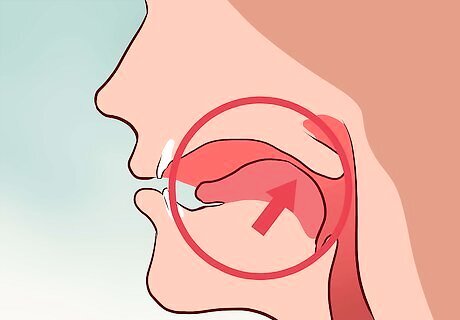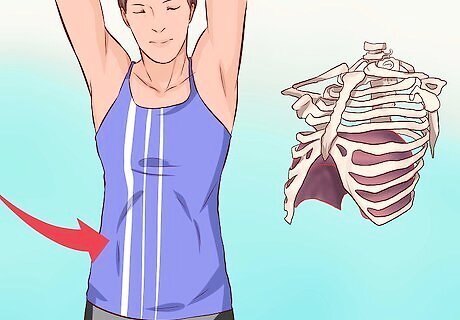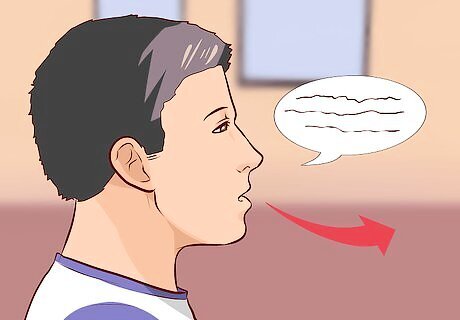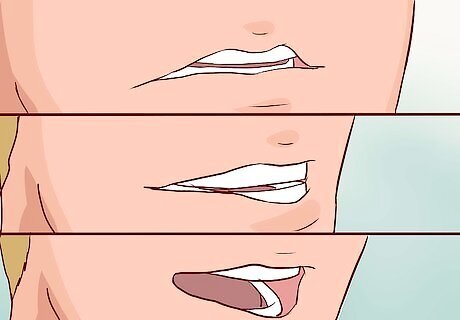
views
Practicing the Distant Effect

Inhale. Take a deep breath, drawing in as much air as possible. The actual practice of throwing your voice is also known as the “distant effect” because it makes your voice sound as though it comes from a distance. In order to throw your voice, you will need to rely on the pressure that comes from squeezing a large amount of air out through narrow passageways. As such, taking a large amount of air into your lungs is an essential first step. Practice inhaling deeply without appearing and sounding obvious. Take large yet quiet breaths through your nose to avoid the “gasping” sound that comes from inhaling deeply through your mouth.

Raise your tongue. Position the back of your tongue so that it nearly touches your soft palate. The soft palate is the soft portion of the roof of your mouth, located near your throat. Use the back of your tongue rather than the tip. Your tongue should be near your soft palate without actually touching it. This action closes off most of your throat. The opening of your throat will need to be narrowed like this in order to produce the muffled voice required for this effect.

Exert pressure with your diaphragm. Pull your stomach in to tighten your diaphragm and apply pressure below your lungs. The diaphragm is a muscle located directly below your lungs. It plays a role in inhalation and exhalation, and the deepest breaths you take are those for which you use your diaphragm. Since the diaphragm is located directly below the lungs and around the upper stomach area, tightening or straining the muscles in your midsection will also tighten your diaphragm. Placing pressure below your lungs constricts the passageway from your lungs to your mouth and nasal cavities. This constriction grants you greater control over your voice and is essential to trapping it inside your throat.

Let out a groan. Slowly exhale, making a groaning noise as your breath leaves your throat. By keeping your airways constricted, you will trap your breath around your larynx. The resulting groan is locked inside your throat, making it sound distant. Practice groaning in this manner several times until you feel comfortable about how trapped or distant the groaning sounds. Inhale deeply each time and constrict your muscles in the same manner, resting your throat when it begins feeling strained or pained.

Make an "ahh" sound. Repeat the inhaling and constricting techniques you used to control your groans. Instead of letting out a low groan, use a simple yet open sound like "ahh." The "ahh" should be long. Start the sound as soon as you begin exhaling and continue it until you push all the air out of your lungs. Note that the sound does not need to be loud, though. If anything, you should expect that the sound will seem muffled, since that is part of what makes it sound so distant. As you practice more, you can gradually work on making the sound louder. To start with, however, merely focus on trapping the noise in your throat. Continue practicing this technique, making the "ahh" sound, until you feel comfortable with it. Stop if your throat begins to feel sore or pained.

Replace the "ahh" with "help me!" When you feel comfortable throwing the "ahh" sound, repeat the breathing and constricting techniques, replacing the "ahh" with a couple of words like "help me." "Help me" is a common phrase used in ventriloquism, since throwing one's voice is often used when creating the illusion of a talking puppet trapped in a chest or box. You could use other phrases, though, like "let me out" or "over here!" The words you choose are up to you, but it is best to keep them simple since throwing your voice strains your muscles. Repeat this phrase as often as necessary until you feel comfortable with the resulting sound.

Limit your practices. Your practices should be no longer than 5 minutes at most. Stop as soon as you feel any pain or severe strain in your throat or lungs. Your larynx, vocal cords, and throat in general are being worked in unusual ways. To avoid damaging or severely straining them, your practice sessions need to be short and focused. As you gain experience, you may be able to practice for slightly longer periods, but your practice sessions should always be fairly short.
Masking Your Mouth

Control your lip movements. The three basic lip positions used when throwing your voice are the relaxed position, smile position, and open position. Create the relaxed position by slightly parting your lips. Keep your jaw loose so that your upper and lower rows of teeth are separated instead of held together. The smile position is common in a ventriloquist act, but it is not used quite as often as the relaxed and open positions in producing the "distant effect." Create the smile position by holding your jaw and lips apart for the relaxed position. Exert the muscles at the corners of your lips, pulling your lips into a slight smile. Your lower lip will extend out slightly more than it would for a usual smile. The open position is great when trying to express shock or surprise, but some tongue movement might be spotted. Hold your mouth agape so that the separation between your upper and lower jaws is noticeable. Keep the corners of your lips slightly upturned, essentially creating a more open version of the smile position.

Practice the easy sounds. The easy sounds can be produced with little to no jaw movement. Practice each of these sounds in front of a mirror until you feel comfortable making them without excess mouth movement. The long and short versions of all five vowels, A, E, I, O, and U, are included among the easy sounds. The hard and soft C sounds and hard and soft G are also among the easy sounds. Other easy sounds include D, H, J, K, L, N, Q, R, S, T, X, and Z.

Work on the challenging sounds using the “front press” position. Challenging sounds, also known as labials, are made using an altered tongue position known as the "front press" or "pull off" position. You usually produce sounds like B and M by momentarily closing your lips, but this movement is obvious and makes it difficult to convince others that the speech comes from a source other than your mouth. Using the "front press" position, your tongue acts as a substitute for one lip. Briefly touch the tip of your tongue to the back of your teeth, applying a light amount of pressure. Make this movement every time your lips would naturally close together to produce a sound. Use this technique for the B, M, P, F, and V sounds. Note that these sounds will not sound as they normally do, but the altered versions produced by this technique are the closest you can come without moving your lips. Do not use much pressure and do not touch the tongue to the roof of your mouth. If you do this, your B will sound like D and your M will sound like N.
Fooling the Audience with Misdirection

Search for the sound. One way to misdirect those listening to you is to pretend that you are searching for the sound in the same way they might be searching. Contrary to the way it may seem, throwing your voice does not mean that you will be able to "bottle" your voice and make it sound as though it is coming from a specific location. A close observer will clearly discover that the voice originates from you, even if you master the technique. Successfully throwing your voice relies on your ability to momentarily convince your audience or listener to look elsewhere for the sound of the voice. People have a natural tendency to look off in directions that others look off in. By appearing as though you are "searching" for the source of the voice, you can cause many people to follow your eyes with their own, effectively joining you in your "search" for the source.

Focus on one pretend source. After you finish “searching” for the source of the voice, a good way to keep the listener misdirected is by keeping your eyes locked on the fake source. This action relies on the same misdirection principle used in searching for your fake source. Human curiosity causes people to look in the same direction that others are looking in. By fixing your gaze on an object or location, those listening to you will naturally follow your line of sight to that object or spot. They may break out of it the longer the illusion lasts, but their initial reaction will be to look where you look.

Use nonverbal communication cues. Enhance the illusion by responding to your “thrown” words as though you were another person. If you are saying something shocking or surprising, make gestures that indicate such an emotion. Raise your eyebrows, quickly cover your mouth with your hand in a phony gasp, or slap your hand to your forehead in mock disbelief. Similarly, if you are listening to words that should anger you, cross your arms, turn your back to the source, or use other gestures to mimic the emotion of anger.




















Comments
0 comment